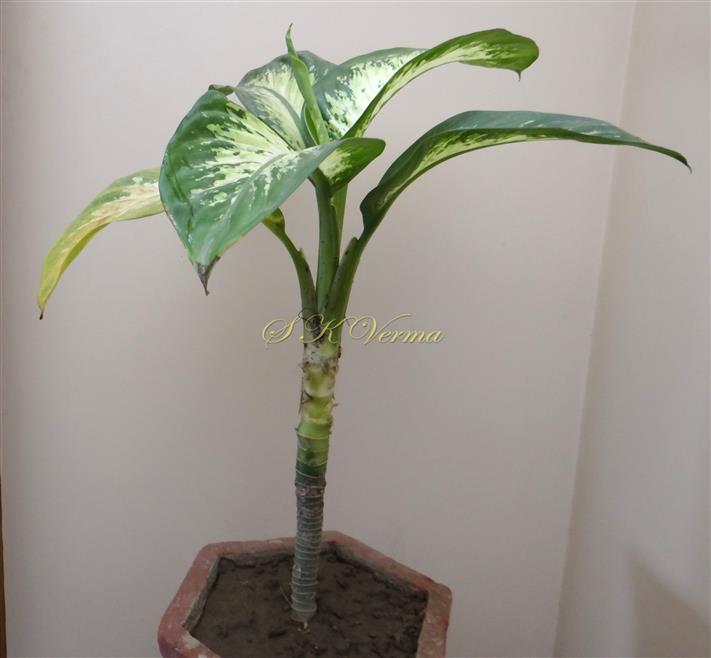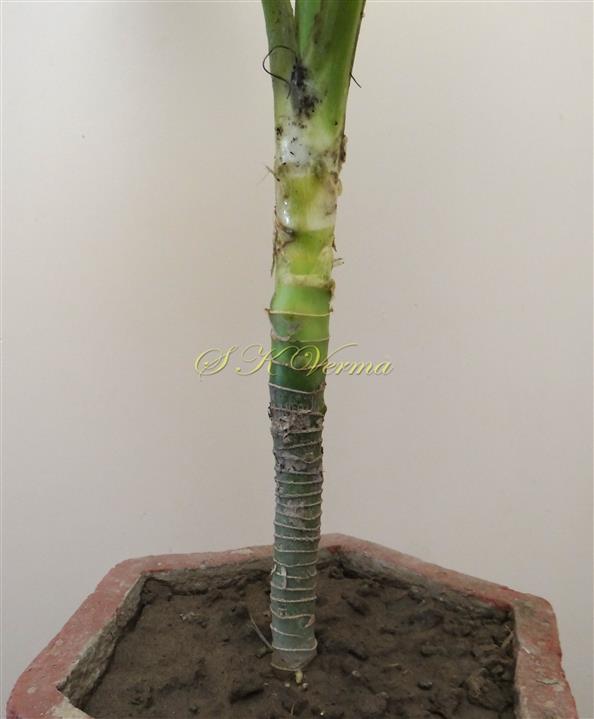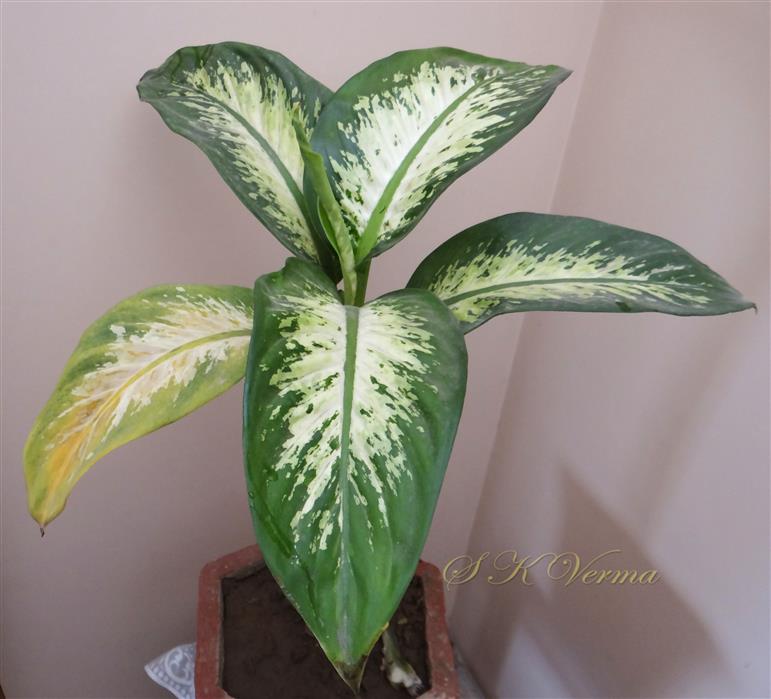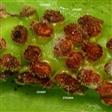DIEFFENBACHIA
Dieffenbachia
Schott, Wiener Z. Kunst 3: 820. 1829; Bailey, Stand. Cycl. Hort. 2: 1006. 1919; Marie C. Neal, Gard. Hawaii 151. 1965; Willis, Dict. Flow. Plants and Ferns, ed. 7: 354. 1966; Flora of Nicaragua; Flora of Panama; Manual of Plants of Costa Rica in World flora on outline; Fl. Pak. @ eFloras.org p. 5.
Evergreen herbs, sometimes robust. Stems erect to decumbent, sometimes +/- rhizomatous, rooting proximally, unbranched distally, internodes distinct, green, smooth, with conspicuous leaf scars. Leaves +/- rosulate near apex; petiole base sheathing, sheath more than half as long as petiole or reaching blade; blade oblong-ovate, elliptic to oblanceolate, dark to light green or sometimes variegated with white, silver, yellow or various shades of green; midrib thick, sulcate or prominent on upper surface, primary lateral veins pinnate, sometimes only weakly differentiated, running into margin, secondary laterals parallel-pinnate, connected by transverse tertiary veins. Inflorescence (spadices) (1-) 2-many in each floral sympodium; cataphylls short and usually inconspicuous; peduncle shorter than petiole; spathe persistent, slightly or distinctly constricted between tube and blade (limb), green, lower part convolute into a usually rather long, persistent tube which splits longitudinally in fruit, upper part expanded into a short, erect or recurved blade; spadix slightly shorter than spathe, female zone entirely adnate to spathe, enclosed within tube, laxly flowered; male zone distal to apex, free, subcylindric, densely flowered, erect; male and female zones separated by subnaked axis with a few, scattered sterile male flowers with reduced staminodes, rarely fertile zones contiguous (D. humilis). Flowers unisexual, perianth absent. Male Flowers: Stamens 4-5, connate into a subsessile, rhomboid to hexagonal synandrium, truncate at apex, sulcate laterally; anthers lateral, common connective thick, fleshy, thecae oblong-ellipsoid, dehiscing by short, apical pore-like slit. Sterile Male Flowers: Composed of a whorl of 3-6, +/- flattened, irregularly globose-ellipsoid, sometimes +/- connate staminodes. Female Flowers: Staminodes 4-5 in a whorl, white, clavate, spreading to erect, surrounding and longer than pistil. Ovary stout, subglobose to ovoid, thick-walled, 1-3-locular, lobed when pleurilocular, ovules 1 per locule, anatropous, placenta axile to basal; style inconspicuous; stigma massive, as broad or broader than ovary, 2-3-lobed or sub hemispheric (when unilocular), usually yellow. Berry: Usually borne in arching infructescences, +/- globose or 2-3-furrowed, stigma remnants persistent, 1-3 seeded, scarlet red to orange. Seeds globose to ovoid, testa smooth, green to blackish green.
59 species
Dieffenbachia seguine
Dieffenbachia seguine
(Jacq.) Schott, Melet. Bot. 1: 20. 1832; Bailey, Stand. Cycl. Hort. 2: 1006. 1919; Fl. Pak. @ eFloras.org p. 5; Flora Tr. E. Afr. @ World Flora Online
Perennial, erect to decumbent herb, 1-2 m tall. Stem unbranched fleshy, green, 2-4 cm in diameter, bearing conspicuous annular leaf scars, internodes distinct. Leaves +/- rosulate near stem apex; leaf blade ovate to oblong-ovate, up to 40 (-47) cm x 15 (-23) cm, green, usually variegated with spots and blotches or white or yellow along the primary veins, apex acuminate, margin entire, base cuneate to subcordate, midrib thick, sulcate or prominent on upper surface, primary lateral veins pinnate, sometimes weakly differentiated. Inflorescence spadix, 1-many in floral sympodium. Peduncle shorter than petiole. Spathe up to 20 cm long, persistent, not constricted between tube and blade (limb), green, lower part convolute, into usually a long, persistent tube which splits longitudinally in fruit, upper part expanded into an erect blade, apex acuminate. Spadix shorter than spathe, partially exserted; proximal part female zone surrounded and hidden by spathe tube, laxly flowered; distal part male zone exserted, sterile appendix lacking; male and female zones separated by a small zone of sterile flowers. Flowers unisexual; perianth absent. Male Flowers: Stamens 4-5, connate into a subsessile, rhomboid to hexagonal synandrium, truncate at apex; anthers lateral, common connective thick and fleshy, thecae oblong-ellipsoid, dehiscence by short, apical pore like slit. Female Flowers: Staminodes 4-5, in a whorl, clavate, white. Ovary subglobose to ovoid, 1-3-locular, 1 ovule per locule, anatropous, basal to axile; style inconspicuous; stigma massive, as broad as or broader than ovary, 2-3-lobed. Berry usually borne in arching infructescences, +/- globose; stigma remnants persistent, 1-3 seeded, red to orange.
Common Names: Dumb Cane



-9034A.jpg)






-9034A.jpg)

